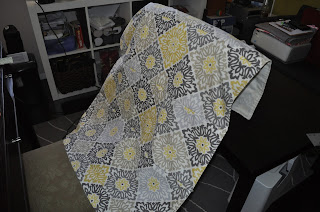When we moved into our new home, the first project we undertook was to cover all the open windows.
We get alot of light in our kitchen and living room, but as much as we like looking out of the windows, we don't need people looking back in.
We came up with a simple set of curtains made from a cute shower curtain and an old curtain rod. We made a matching set for the kitchen as well. Unfortunately, they are not super-great on blocking light. Also, if someone is at the front door, they can usually get a peak inside. Not great if you are trying to avoid salespeople or other weirdos.
See all that light? Not very private.
We found a few ideas on the internet, but in the end we combined a few ideas to come up with our own.
First we gather up our supplies:
wooden dowels
29" mini blinds
white plastic rings
two kinds of fabric
(one to face the inside of the house and the other to help filter out some of the light)
sewing thread
We also used an iron and a sewing machine. Basics like pencils, rulers and glue will also be needed.
As with any fabric project, we begin with ironing all the fabric to get out all of the sharp folded edges.
Whilst I ironed, my husband laid out the mini blinds. We really only want the strings and the main raising and lowering mechanism, so we needed to separate it from the rest of the blinds.
Starting at the base of the blinds, he started trimming the connecting strings to remove the individual blinds leaving the two longer strings at each support.
In the end, after the individual blinds are removed, this is what you will end up with.
Next, we cut the fabric to fit the size of our windows. We needed to make it about 1.5" to 2" wider than the window to allow for folding the fabric to create clean edges. When determining the height required, we had to do some math.
You need to decide how many folds you want to have in the shade overall. For each fold and for the bottom of the shade, we used between 1.5" to 2" in additional length to account for the material wrapping around each dowel. We had the fabric covering the face of the mini blind mechanism at the top of the shade, so you will need to account for this dimension as well.
We always have our project manager on hand to make sure we are staying on task.
Once we have the two fabrics cut to size, we sew three edges together inside out (like a pillow).
To get the most accurate dimension for the fabric wrapping the dowels, we measured the dowel in the fabric. Buzzed the line in the fabric and double checked that the dowel could still fit in the sleeve.
Once we had the accurate measurement down, we made the appropriate lines for all the folds in pencil on the fabric and started buzzing (sewing) all the lines together.
Here you can see the folds and the lines that we used to sew the folds together.
Here are the views from the front and back.
Next, my husband got to use his favorite toy and cut the dowels down to size. We made them slightly shorter than the width of the shade so they would not be visible.
Next, we need to locate where the support lines will be attached to each dowel. Measure the distances between the support lines on the mini blinds.
At each support point on each dowel, using a simple needle and thread, sew a single plastic ring to the dowel within the fabric. The orientation of the ring should allow for the support lines to run smoothly through them running up and down behind the shades.
Finally, we get to mount the mini blind mechanism and support lines to the front door.
You will need to refer to your particular mini blind packaging to find out how to attach this all to the door. Wherever your mini blind mount ends up above the window opening, be sure to take this into consideration in the overall length of the shades.
We mounted ours a little high the first time around, so we had to mount it a few times.
You will need to refer to your particular mini blind packaging to find out how to attach this all to the door. Wherever your mini blind mount ends up above the window opening, be sure to take this into consideration in the overall length of the shades.
We mounted ours a little high the first time around, so we had to mount it a few times.
Once the mini blind mechanism is mounted in the proper place, we need to attach the fabric shade itself. We decided to go with velcro since we did not want to deal with messy glues, clamps and the like. We attached one side of the velcro to the face of the mini blind mechanism and the other to the back side of the top of the fabric shade. Attach together.
Once the fabric is in place, we need to run the support lines through the plastic rings and tied into the last rings at the bottom dowel. Now you can use the pull strings from your mini blind mechanism to pull the fabric shades up and down! Like store bought Roman shades!
The great thing about the velcro is that you can take your time in getting the fabric in just the right place to hang straight.
The extra fabric makes for more light filtering. The extra width prevents anyone from peering in around the edges.
Huzzah! A professional-looking, workable privacy cover for our front door! Beautiful!







































